
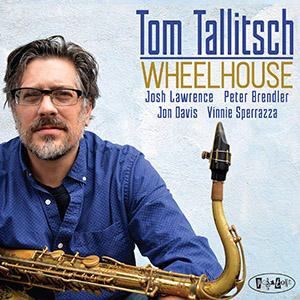 Wheelhouse is Tom Tallitsch’s fifth outing for Posi-Tone Records (eight overall) from one of the most consistently solid performers in that label’s stable of quality jazz performers. Though this 2018 release again sees the tenor sax master heading up a roster who have led their own notable dates for the label, but this one pairs Tallitsch with a trumpeter for the first time on a Tallitsch record, in the form of the talented Josh Lawrence. Also on board is Jon Davis (piano), Peter Brendler (bass) and Vinnie Sperrazza (drums).
Wheelhouse is Tom Tallitsch’s fifth outing for Posi-Tone Records (eight overall) from one of the most consistently solid performers in that label’s stable of quality jazz performers. Though this 2018 release again sees the tenor sax master heading up a roster who have led their own notable dates for the label, but this one pairs Tallitsch with a trumpeter for the first time on a Tallitsch record, in the form of the talented Josh Lawrence. Also on board is Jon Davis (piano), Peter Brendler (bass) and Vinnie Sperrazza (drums).
Combine the proven quintet format with Tallitsch’s penchant for penning memorable post-bop and hard bop tunes in the classic style, and Wheelhouse is akin to Blue Note pulling out a vintage mid-sixties session from the vault performed by label heroes Paul Chambers, Donald Byrd, Herbie Hancock and the like. Even the spotless, analog-warm production by Marc Free evokes Rudy Van Gelder.
Though Tallitsch has been known to throw out an offbeat cover or two in the past, he sticks to all-originals this go around. “Wheelhouse” features a tale of two rhythm patterns, but when it settles into a swing mindset, Tallitsch displays that ingratiating, soulful tenor in full . Not one to leave a wealth of talent idle, Davis, Lawrence and Sperrazza get their own savory features as well. “Schlep City” is a blues-based shuffle where Lawrence’s trumpet spotlight more than recalls Lee Morgan. Sperrazza’s dynamic rhythm-ing drives “Red Eye” along as Tallitsch and Lawrence combine for funky lead lines prior to them taking turns on thoughtful solos.
Brendler’s bass pattern kicks off the slow swinging “Paulus Hook,” which has a melody imbued with melancholy nicely captured by Tallitsch’s aside. “One For Jonny” is a tender ballad, a choice opportunity for Lawrence to show off a lavish affecting tone. He later fills in some harmony behind the leader’s own heartfelt solo. To top it all off, the swaying soul-jazz of “Gas Station Hot Dog” hearkens back to the RnB-soaked numbers once championed by Morgan and Lou Donaldson, and Davis’ crisp lines here as they are everywhere else are delightful throwback to when jazz piano was played with a lot of soulfulness.
Tom Tallitsch’s Wheelhouse is all in a day’s work for this underappreciated tenor saxman, who once again demonstrates the continued vitality of the hard bop form. If that kind of jazz is in your wheelhouse, then this album is sure to be as well.

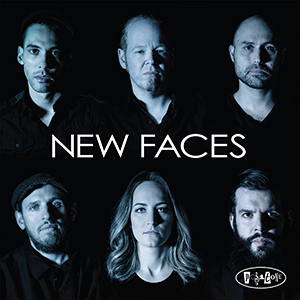
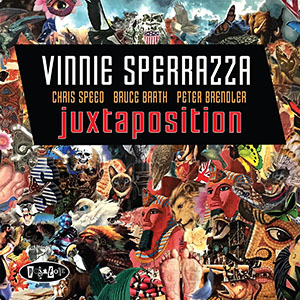
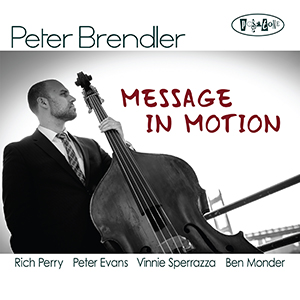
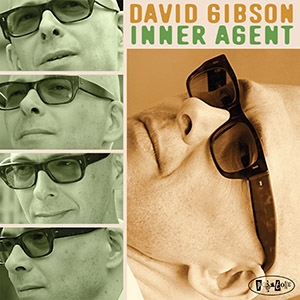 David Gibson is a serious ‘student’ of his chosen instrument: the trombone. Not only does his virtuosity enable the songs on Inner Agent to spin out and display passages with dazzling facility but the emotional depth of his playing enables him to ‘sing’ with uncanny authority. More than anything, however, this recording follows in the great tradition of the trombone, paying luminous homage to the great Curtis Fuller with two tunes – ‘The Court’ and ‘Sweetness’. Gibson also takes his reverential manner many steps further with beguiling compositions of his own. In the magnificent workings of ‘The Scythe’, for instance, his music and his playing combines accuracy and clarity with a warm ambience and almost tangible texture. The other players in the ensemble also possess a remarkable aptitude for agility in their loping, leaping and mutable soli. Together, Gibson and his cohort, especially trumpeter Freddie Hendrix – whose musical character is cast as a doppelgänger for the trombonist’s own – have succeeded in leaving us with a performance of exceptional beauty.
David Gibson is a serious ‘student’ of his chosen instrument: the trombone. Not only does his virtuosity enable the songs on Inner Agent to spin out and display passages with dazzling facility but the emotional depth of his playing enables him to ‘sing’ with uncanny authority. More than anything, however, this recording follows in the great tradition of the trombone, paying luminous homage to the great Curtis Fuller with two tunes – ‘The Court’ and ‘Sweetness’. Gibson also takes his reverential manner many steps further with beguiling compositions of his own. In the magnificent workings of ‘The Scythe’, for instance, his music and his playing combines accuracy and clarity with a warm ambience and almost tangible texture. The other players in the ensemble also possess a remarkable aptitude for agility in their loping, leaping and mutable soli. Together, Gibson and his cohort, especially trumpeter Freddie Hendrix – whose musical character is cast as a doppelgänger for the trombonist’s own – have succeeded in leaving us with a performance of exceptional beauty.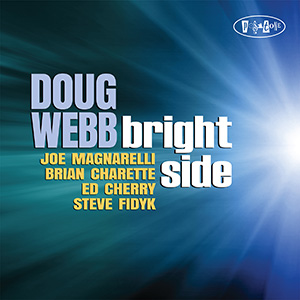 Doug Webb’s most emotional call to look on the Bright Side is a most appropriate offering in these ‘times of trouble’. In this respect, Julie Styne’s feature, ‘Guess I’ll Hang My Tears Out To Dry’ becomes the disc’s clarion call to listeners in search of peace. But let it be suggested that the saxophonist’s disc in question is an endless stream of moping about current events and an apocalyptic sermon about the state of the art, it has to be said that Webb is not one to weep and moan about it. Rather he is more apt to press on and serve up such delicacies as ‘Steak Sauce’ and ‘Funky Medina’. Making an ebullient record takes not only a sense of fun, but elegant simplicity, given to joyous celebration of all things musical. It also shows Webb to possess a more theatrically developed virtuosity necessary for a performance that highlights his compelling works. More rewarding on the ensemble front, both structurally and emotionally is Webb’s prominent interaction with musical partners who articulate the loose-limbed elegance of the music with impressive timbral variety.
Doug Webb’s most emotional call to look on the Bright Side is a most appropriate offering in these ‘times of trouble’. In this respect, Julie Styne’s feature, ‘Guess I’ll Hang My Tears Out To Dry’ becomes the disc’s clarion call to listeners in search of peace. But let it be suggested that the saxophonist’s disc in question is an endless stream of moping about current events and an apocalyptic sermon about the state of the art, it has to be said that Webb is not one to weep and moan about it. Rather he is more apt to press on and serve up such delicacies as ‘Steak Sauce’ and ‘Funky Medina’. Making an ebullient record takes not only a sense of fun, but elegant simplicity, given to joyous celebration of all things musical. It also shows Webb to possess a more theatrically developed virtuosity necessary for a performance that highlights his compelling works. More rewarding on the ensemble front, both structurally and emotionally is Webb’s prominent interaction with musical partners who articulate the loose-limbed elegance of the music with impressive timbral variety.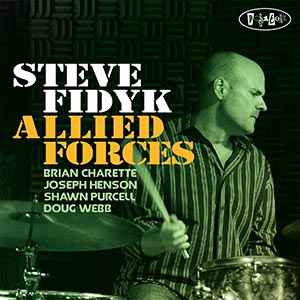 If it were time to draw up a list of the finest performances of 2016, then Steve Fidyk’s Allied Forces would feature very prominently on it. For one thing, this is not the usual organ/guitar/drum recording but an intelligent spinoff that features an infinitely larger and fascinating tonal colour palette with the addition of an alto and a tenor saxophone. The recording also shows the drummer/leader, Fidyk to not only possess formidable artistic gifts as a percussion colourist, but also a drummer of immense melodic capability. Fidyk’s musicianship also shows to be a bold instrumentalist and gifted writer. These complementary aspects paint a portrait of a musician with the facility to transform and illuminate in a myriad styles. It helps to have a sensibility rooted in, arguably, the last, and most significant idiom in Jazz – bebop. The group’s performance of Charlie Parker’s ingenious ‘Moose The Mooche’ and Thelonious Monk’s iconic ‘Evidence’ gets behind the irrepressible rhythmic dynamic of the music that Parker and Monk helped to create with Kenny Clarke and Dizzy Gillespie. But Fidyk is also a chameleonic musician. Consider the manner in which he whips up a funky storm on ‘Doin’ The Shake’. And the, of course, there’s the rousing rendition of Frank Foster’s ‘Shiny Stockings’ a marvellous bookend to ‘Evidence’, which gets things started. An album to die for.
If it were time to draw up a list of the finest performances of 2016, then Steve Fidyk’s Allied Forces would feature very prominently on it. For one thing, this is not the usual organ/guitar/drum recording but an intelligent spinoff that features an infinitely larger and fascinating tonal colour palette with the addition of an alto and a tenor saxophone. The recording also shows the drummer/leader, Fidyk to not only possess formidable artistic gifts as a percussion colourist, but also a drummer of immense melodic capability. Fidyk’s musicianship also shows to be a bold instrumentalist and gifted writer. These complementary aspects paint a portrait of a musician with the facility to transform and illuminate in a myriad styles. It helps to have a sensibility rooted in, arguably, the last, and most significant idiom in Jazz – bebop. The group’s performance of Charlie Parker’s ingenious ‘Moose The Mooche’ and Thelonious Monk’s iconic ‘Evidence’ gets behind the irrepressible rhythmic dynamic of the music that Parker and Monk helped to create with Kenny Clarke and Dizzy Gillespie. But Fidyk is also a chameleonic musician. Consider the manner in which he whips up a funky storm on ‘Doin’ The Shake’. And the, of course, there’s the rousing rendition of Frank Foster’s ‘Shiny Stockings’ a marvellous bookend to ‘Evidence’, which gets things started. An album to die for.